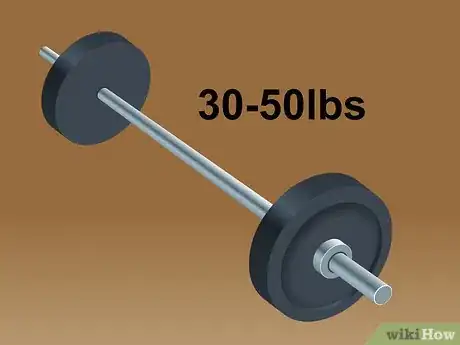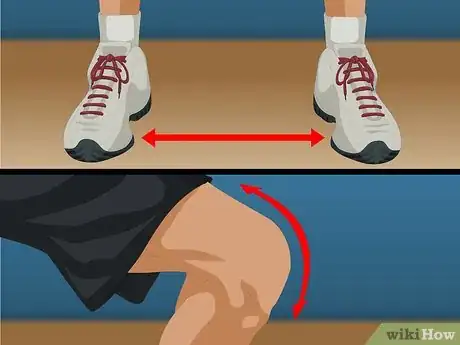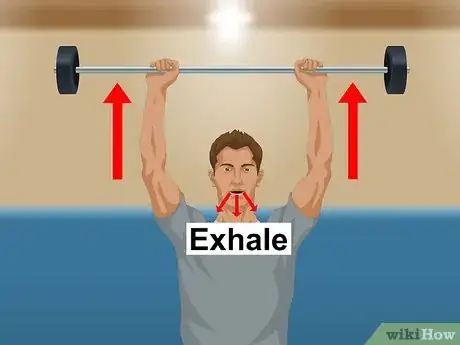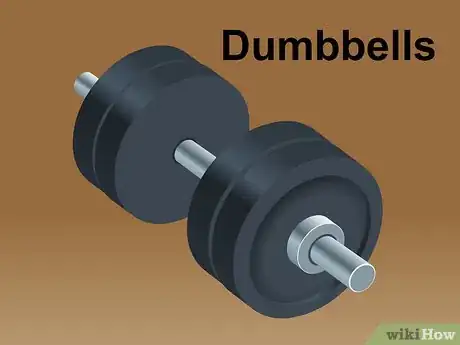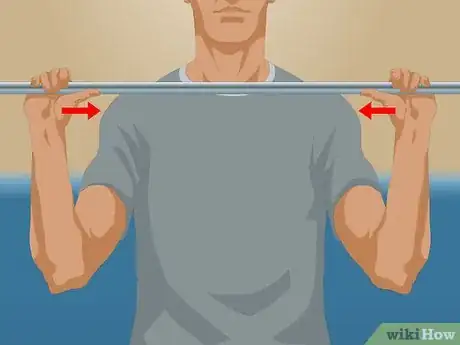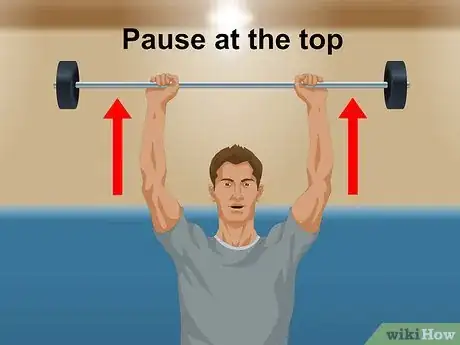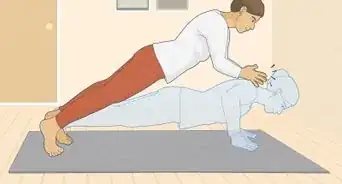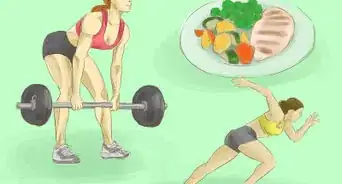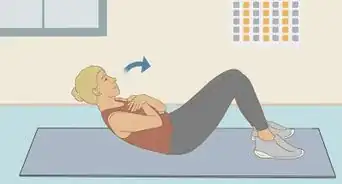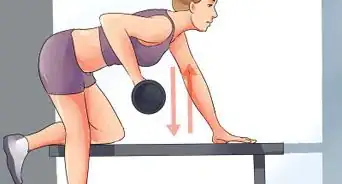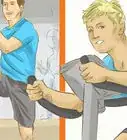This article was co-authored by Danny Gordon. Danny Gordon is an American College of Sports Medicine (ACSM) Certified Personal Trainer and Owner of The Body Studio for Fitness, a fitness studio based in the San Francisco Bay Area. With over 20 years of physical training and teaching experience, he has focused his studio on semi-private personal training. Danny received his Personal Trainer Certification from the California State University, East Bay and the American College of Sports Medicine (ACSM).
There are 8 references cited in this article, which can be found at the bottom of the page.
This article has been viewed 221,610 times.
The Military Press is a shoulder exercise that focuses primarily on the deltoids, rear deltoids, and triceps. Since it is a compound exercise (meaning it uses multiple muscles), it is a great way to train your upper body. However, it also means the movement is slightly more complicated, making perfect form much more crucial to avoid injury.
Steps
Standing Military Press (Barbell)
-
1Use the military press to work out your shoulders and upper arms. The basic exercise is simple. You start with the barbell resting on your collarbone, around shoulder height. You then lift the weight up until your arms are almost fully extended straight up. Finish one rep by lowering the weight back down to your collarbone.
- Those with low-back problems should focus on seated military presses.[1]
-
2Choose a barbell that you can comfortably lift to shoulder height to start with. Don't start a new exercise with the hardest weight you can muster. Begin instead with a barbell (the long rod with weights on either end), that you can comfortably pick up and put down. Anywhere from 30-50lbs is likely a good place to start, depending on your strength.Advertisement
-
3Set the barbell on a rack at roughly shoulder height. You do not start most military presses from the ground, but rather from a weight already lifted in the air. Set the barbell on the rack with the weights attached. You can also have a partner hand you the bar.
- In general, you'll be using the squat racks to position the barbell.
- You can lift the weight from the ground, but make sure you keep your spine straight and bend from your knees to pick it up.
-
4Grip the bar slightly wider than shoulder width, with your palms facing forward and up. Once you have it, remove it from the rack and take a step back. The weight should be resting on your collar bone, with your chin tilted slightly up to make room.
-
5Set your feet shoulder-width apart. Slightly bend your knees so that they aren't over extended. You want to be comfortable and on balance. Some people stagger their feet (one head, one behind) for better balance.
-
6Exhale as you push the bar straight above your head. Extend your arms up simultaneously until they are straight. The bar will be above you and slightly in front of your head. Hold this position for a half second -- this is your starting pose.
-
7Inhale as you lower the bar back to your collar bone. Keep your feet still and your movements slow and regular. Your spine should not move and your back must be straight. If you're struggling to keep your back straight, you have too much weight.
-
8Push the bar back up to finish one rep. As you exhale, slowly and evenly push the bar back into the air. This is one rep. Rest for 1-2 seconds at the top, then lower the bar and repeat for your chosen number of reps.
- In general, you want to do enough reps so that the last 2-3 are tough, but still doable. Try and do three even sets.[6]
Introducing Variety into your Military Press
-
1Try the seated military press. It is the same motion, just adapted to put less pressure on your lower back. If you've struggled with back pain in the past, this is the best option for you. You should have a friend help you grip the bar and put it into position, or you can sit with the bar in your lap and push it up yourself. When adapting to a seated military press:
- Tilt the seat slightly back, only 5-6 degrees, for comfort.
- Avoid bending backward to place the bar back on a rack. This puts extreme pressure on your back and arms.
- You do not need a seat with a back to do this -- you can still protect your back just sitting on a bench while performing the military press.[7]
- Keep your feet flat on the ground and press up through your heels as you lift.[8]
-
2Use dumbbells for better shoulder isolation. Dumbbells are the one-handed weights, and they introduce a new set of challenges and benefits. Because they are not connected, you have to focus on keeping your wrists and hands still as you work out. This helps tone smaller muscles in your arm and improves your form. You can use them either standing or sitting. However, it also increases the chances of poor form and injuries if you aren't diligent about proper mechanics:
- Keep your palms facing the same direction the entire time.
- Make sure both hands go up to the same height and back down to the same height.
- Use slow, controlled movements to ensure that your arms go up in a straight line, not outward or curved.[9]
-
3Turn your hands inward to work on different heads of your muscles. You'll work slightly different shoulder muscles if you turn your palms to face each other. This usually requires dumbbells, but you can also use a Swiss Bar, which is made for different grips. The rest of the motion is the same.
-
4Try a kneeling press to improve form and core stability. Kneel on a bench, with your feet hanging off the end, then perform a military press with dumbbells. Shortening your stance requires increased balance in your core, and proper mechanics become essential. If you lose your balance you've arched your back, moved your arms sideways, or otherwise used improper form. Fix it before continuing.
-
5Try different overhead presses to add variety to your workouts. The military press is the most common overhead press, but that doesn't mean it is the only one. Several other variations exist, with varying degrees of difficulty:
- Javelin Press: Hold a barbell in the center, like you were throwing a spear. Then, using only this arm, perform a military press while keeping the bar parallel to the ground. Tighten your core to prevent leaning or angling to this side.
- Bottoms-Up Press: In the normal start position (hands near chest), grip kettlebells so that the weight is above your hands. Your palms face forward. Press up like normal, keeping the weights above your hands. Your forearms get an increased workout, and your form needs to be perfect to keep the bells from dropping or sliding.[10]
Improving Form and Power
-
1Ensure you have the proper grip width with the thumb test. The right grip is largely a matter of comfort. However, if you're complete unsure where to grip the bar, or you're experiencing discomfort, you can do this simple test to find the right grip.
- Grab a weightless bar and set it in the start position across your chest.
- Point your thumbs inward, towards your neck.
- Slide your hands until the tips of your thumbs touch the outside of your shoulders.[11]
-
2Stagger your feet for added stability and comfort. If you're struggling to keep your balance while pressing, put one foot 6-8" forward and the other 6-8" back. they should still be roughly shoulder-width apart. Having a straight, sturdy spine is much more important than having your feet even. Every set, switch which foot is forward and which is back.
- To keep from leaning forward, the front knee should be slightly bent.[12]
-
3Slow down the movement and pause at the top for added burn. The slower and more controlled your movements, the better. Working slowly forces you to keep your balance, using your arms and core in tandem to keep everything smooth. You want fluid movements, and pausing at the top will cause a deep but satisfying burn.
-
4Sculpt your shoulders with smaller, more isolated exercises to build up muscle. If you're struggling with the military press, you might transition to smaller exercises to build up some muscles. After 3-4 weeks, you can then tackle the military press with new strength. Some good exercises include:
- Shoulder Flies
- Pull-ups
- Pike Presses
- Home shoulder workouts.
Warnings
- Do not swing your hips, and always keep the bar under control. If you are wobbling under the bar and can't keep your hips stationary then you should lower the weight your using.⧼thumbs_response⧽
- Have a spotter with you when starting out or using extreme weights.⧼thumbs_response⧽
Things You'll Need
- A barbell, and a 20 kg (45 lb) weight set. As in weighted plates to load up the bar.
- It is recommended to start with the light, thin bar, not the thick Olympic ones.
References
- ↑ http://www.exrx.net/WeightExercises/DeltoidAnterior/BBMilitaryPress.html
- ↑ Danny Gordon. Certified Fitness Coach. Expert Interview. 18 October 2019.
- ↑ Danny Gordon. Certified Fitness Coach. Expert Interview. 18 October 2019.
- ↑ http://www.bodybuilding.com/exercises/detail/view/name/standing-military-press
- ↑ Danny Gordon. Certified Fitness Coach. Expert Interview. 18 October 2019.
- ↑ http://www.bodybuilding.com/exercises/detail/view/name/standing-military-press
- ↑ http://www.bodybuilding.com/exercises/detail/view/name/seated-barbell-military-press
- ↑ Danny Gordon. Certified Fitness Coach. Expert Interview. 18 October 2019.
- ↑ v
About This Article
To work out your shoulders and upper arms with a military press, start by selecting a barbell that you can comfortably lift to shoulder height. Between 30-50 lbs (14-23 kg) is a good starting weight for many people. Set the barbell in a rack at shoulder height, then stand in front of it with your knees slightly bent and your feet shoulder width apart. Grab the barbell with your hands slightly wider than shoulder width apart, and keep your palms facing forward and up. Exhale while pushing the barbell straight up over your head with both arms. Engage your glutes and core muscles at the same time. Hold the bar up for about half a second, then inhale as you lower it back down to collar-bone height. Keep your back straight and finish the move with your elbows at a 90° angle. Exhale and push the bar back up above your head to complete 1 rep. Rest for 1-2 seconds between each rep. When you’re starting out, aim to do 1 set of 8-10 reps. As you build strength, you should be able to gradually increase the number of reps and sets you can do comfortably, as well as the amount of weight you can press. For more tips, like how to improve your form, read on!

